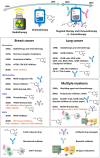Therapeutic Advances in Oncology
- PMID: 33670524
- PMCID: PMC7922397
- DOI: 10.3390/ijms22042008
Therapeutic Advances in Oncology
Abstract
Around 77 new oncology drugs were approved by the FDA in the past five years; however, most cancers remain untreated. Small molecules and antibodies are dominant therapeutic modalities in oncology. Antibody-drug conjugates, bispecific antibodies, peptides, cell, and gene-therapies are emerging to address the unmet patient need. Advancement in the discovery and development platforms, identification of novel targets, and emergence of new technologies have greatly expanded the treatment options for patients. Here, we provide an overview of various therapeutic modalities and the current treatment options in oncology, and an in-depth discussion of the therapeutics in the preclinical stage for the treatment of breast cancer, lung cancer, and multiple myeloma.
Keywords: breast cancer; innovation; lung cancer; multiple myeloma; oncology; therapeutic modalities.
Conflict of interest statement
At the time of this manuscript preparation, all authors were employees of Eli Lilly and Company. The authors declare no conflict of interest.
Figures





References
-
- American Cancer Society (ACS) Global Cancer Facts & Figures. American Cancer Society; Atlanta, GA, USA: 2018. [(accessed on 1 September 2020)]. Available online: www.cancer.org.
-
- IQVIA Global Oncology Trends 2019. Therapeutics, Clinical Development and Health System Implications. [(accessed on 30 May 2019)]; Available online: www.iqvia.com.
Publication types
MeSH terms
Substances
LinkOut - more resources
Full Text Sources
Other Literature Sources
Medical
Miscellaneous

